This week, as you may have heard, Auckland finally joined the league of grown-up cities. After 174 years of existence, Auckland finally started to run electric passenger trains on a local metro network, with the first few of their 57 new CAF Spanish-made trains joining the network. Out go the diesel-powered locomotives pulling railway carriages, in come three-car electric units that are faster, quieter, and with a bit of luck, a lot more reliable.
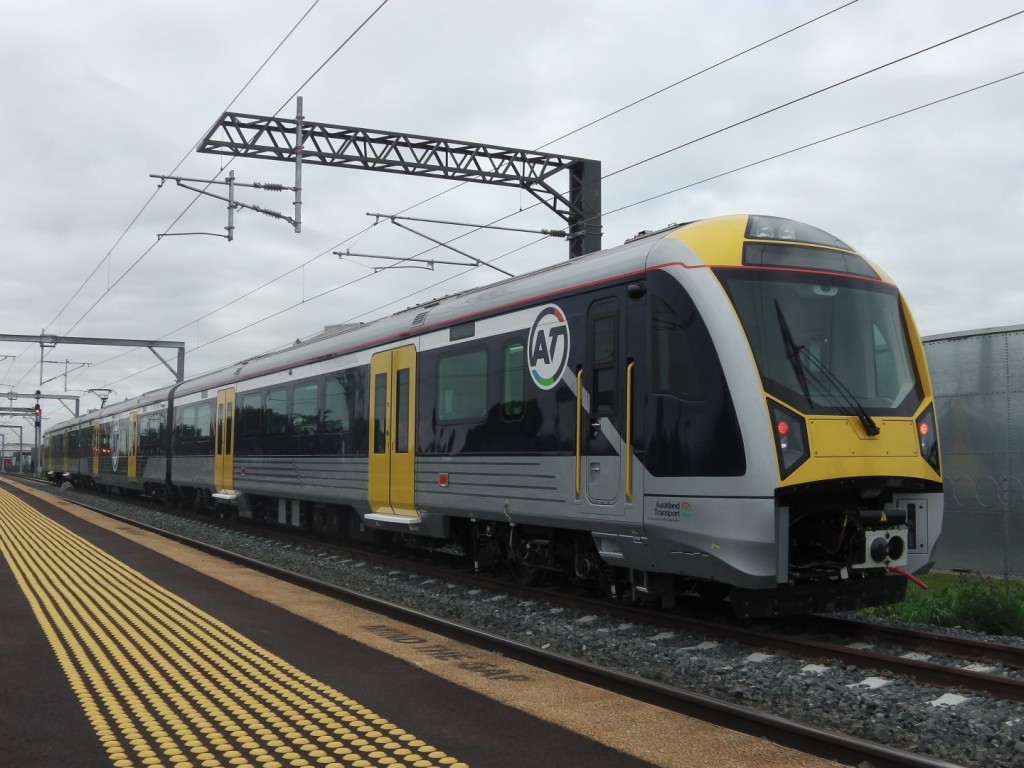
Photo credit to nzrailphotos.co.nz
There has been extensive coverage of this fairly momentous occasion over at the generally fantastic Transport Blog, but there has been newspaper and TV coverage as well, and (as they do) politicians crowding around to have their photo taken and claim responsibility. As you know, it is primarily Mayor Len Brown that has been the real push behind this, and good on him – there is still sniping feedback from some of the other Auckland Councilors like (the well-named) Dick Quax – but predominantly it has been well-received. The network in Auckland has, somewhat amazingly, three separate lines and I’ve travelled them all recently. There is a Western line, an Eastern line, and the other one which I guess is the Southern line, as it sure as heck can’t be a Northern line until they find a way of crossing the Waitemata harbour. All of the lines congregate into downtown Auckland, popping passengers out of the ground at Britomart, as does the once-every-couple-of-days Overland service from Wellington. Transport Blog and Generation Zero have pulled together to create the excellent resource and plan for the future of Auckland that is the Congestion Free Network.
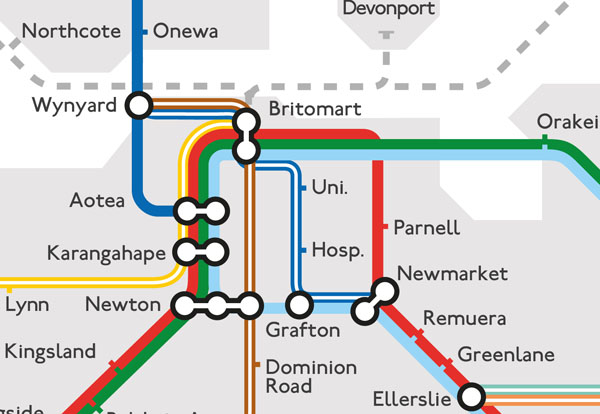
Of course in Wellington we have had electric trains for many, many years, and we have quite a few train lines too, with an extensive branch network up the Hutt Valley, as well as over to Porirua and north to Kapiti, and the frankly quite exciting service rattling it’s way up the hills to Khandallah and Johnsonville. I think I’m right in saying that all of these are electric ? Perhaps some of the long distance ones are diesel, like the Wairarapa wanderer? but regardless, Wellington has long held the rightful title of commuter train capital of New Zealand.
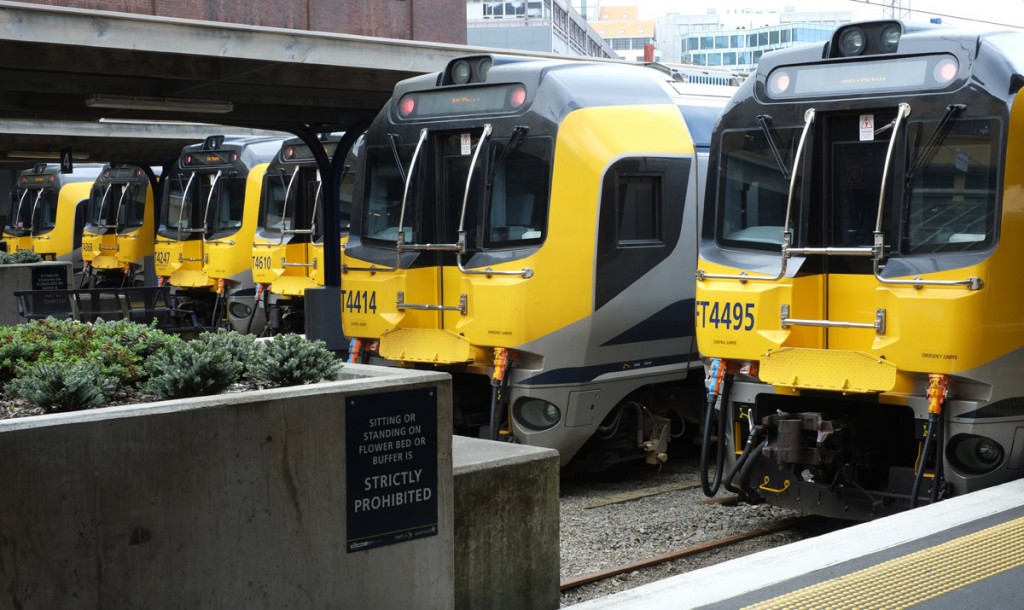
Well, not any more. Although Wellington has, by proportion of its population, still the largest percentage of people making their way to work by train, Auckland’s total train-bound numbers have been creeping up and up over the past 10 years or so, and quite incredibly, Auckland has now overtaken Wellington in terms of sheer numbers – there are now more people physically taking trains as transport in Auckland than there are in Wellington, if we believe the figures produced by Transport Blog. Those figures are just going to keep on climbing too, especially now that the trains up there are electric. those figures will absolutely sky-rocket in future years if Brown gets his way and the CTRL project goes ahead, although the government are clearly still not keen to get involved in that possibility just yet.
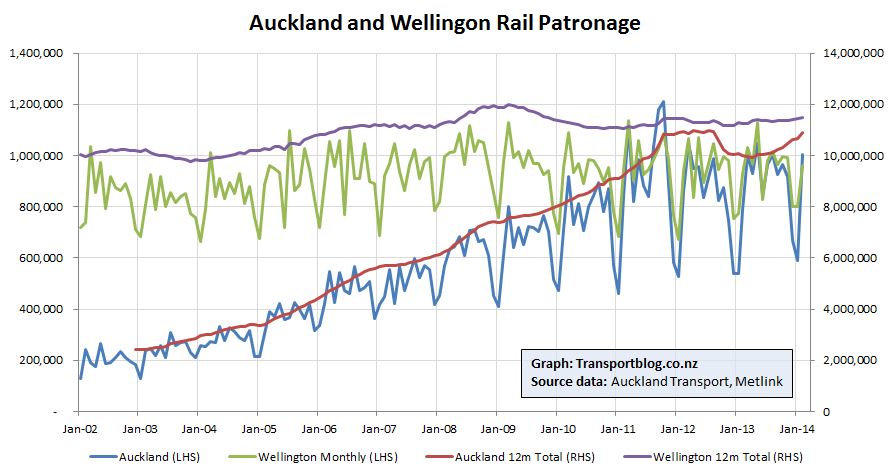
Auckland’s total percentage of rail commuters will probably always be way less than Wellington’s percentage, given how much they love their cars and motorways up there, but the plain truth is that Wellington reached a plateau of rail passengers many years ago, and we will be doing well to keep the numbers stable, let alone stop them falling once Transmission Gully is in place (GWRC figures, I think, forecast an approx 20% drop off of numbers taking the train from Kapiti due to car travel being made easier). Exactly where all those additional cars are going to fit into Wellington has not been figured out yet, seeing as we are quite full down here already. Perhaps they will just sit on the road and never find a parking space, much the same as they do all day long in Auckland, and for a half hour each day in Wellington. Congestion. The solution to all your parking needs…

But back to trains. Auckland’s wild crowing about the Britomart development always seemed a ludicrous thing to me. Excitedly billed as “The World’s First Underground Diesel Train Station” when it was opened – like that’s a good thing? There is a damn good reason why diesel trains are not run underground anywhere else in the world, and that is because of the smokey pollution, which was only avoided in Auckland by virtue of them having such a paucity of services in their early days. Great termini of the world often have diesel trains, but they normally cope with that pollution thing by having a decent size volume as well. Grand arched sheds like that in Koln or York, where the trains pass through, or end of line stations like Paddington Station, Kings Cross, St Pancras, all with their massive steel arches over the station volumes, swallowing up the diesel particulate particles and redistributing it over wider London via the wings of sooty pigeons.
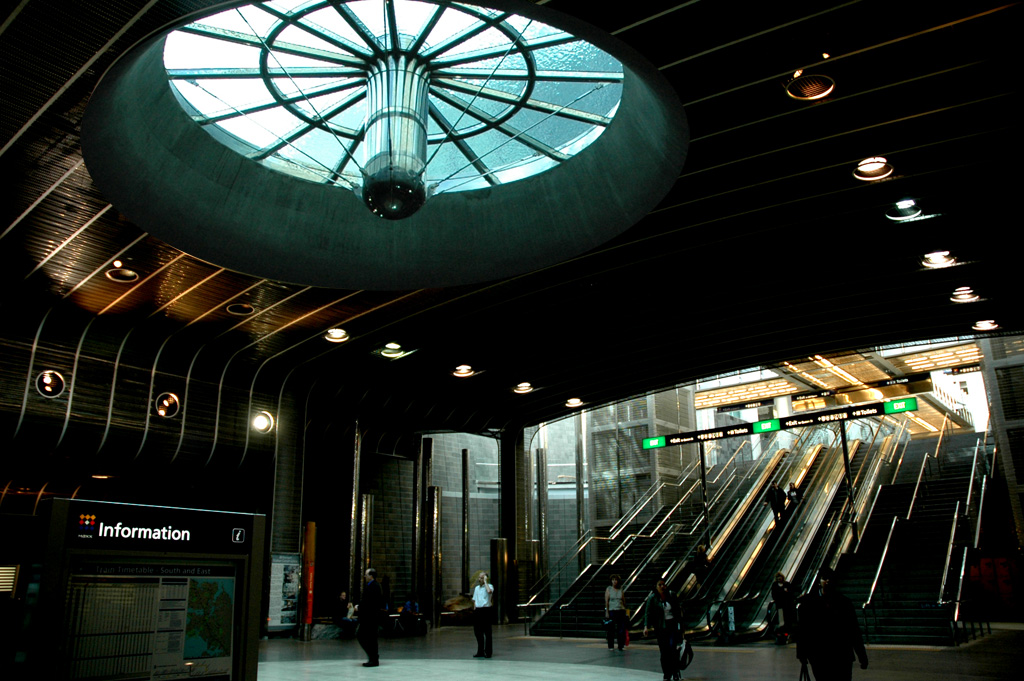
Britomart is a poor, sad excuse for a train station, designed and built with an appalling lack of forethought by engineers and architects who could not, quite frankly, see the wood for the trees. While it has become quite clear to Auckland transport in recent years that a one-sided terminus is a distinct draw-back when it comes to running a metro service, and what they need is a bit of the old through-action, this thought appears to have been spectacularly free from the minds of the designers a mere ten years ago when Britomart was built. Despite the huge, expensive, extensive task of rebuilding the former GPO to become a train station, the route through wasn’t incorporated, and so a lot of that work will have to be redone when they eventually try to ram the extension through.

I despaired when I first saw it, although it just makes me laugh now, with it’s silver-foil covered kauri trees and the glass louvred box that counts as an architectural gesture. Of course, Auckland used to have a station here many many years ago, which was then shifted, bizarrely, back to the other side of Parnell where it was no use to man nor beast, and now sits abandoned, used as cheap and crappy student housing, in which Auckland specializes so well.
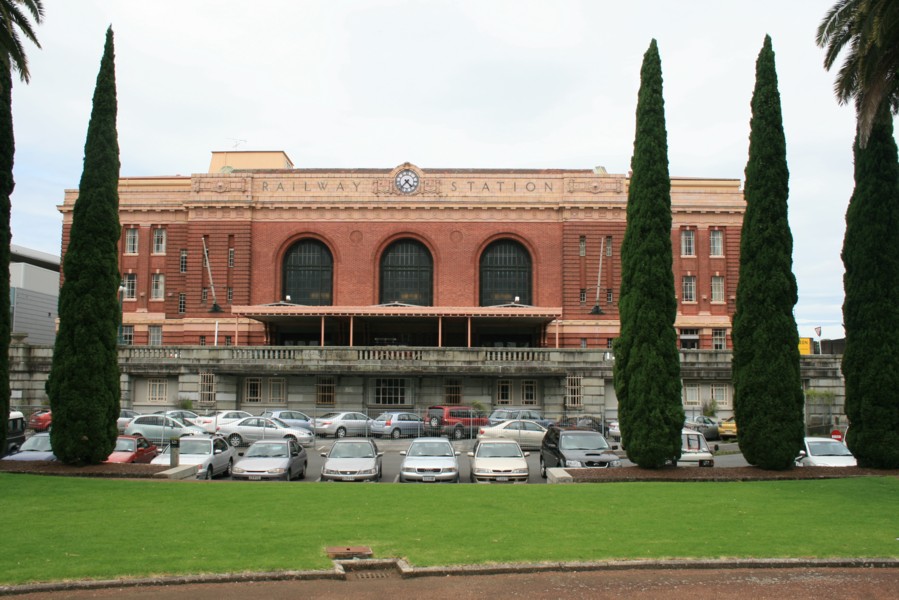
By the same token, it has to be said that we here in Wellington used to have a more convenient station as well, the Te Aro station, sitting down virtually at the doorstep of Chris Parkinson’s black box of the Museum Hotel. How useful would that have been if they had kept that! But no… Admittedly, it would have been obstructive having tracks along the waterfront and that was undoubtedly one of the reasons it went away as well, but instead of a pair of train tracks, we built a six to eight lane highway there instead. Because, that’s a lot easier to cross….
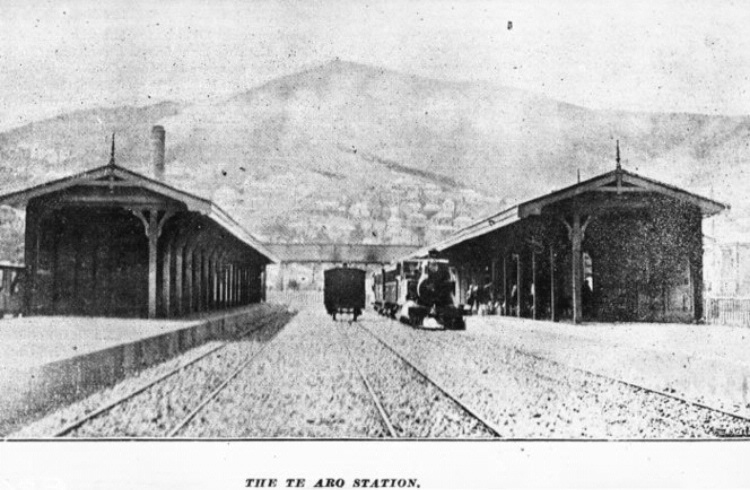
Regardless of all that, it is a shame that Wellington has lost its lead as railway commuter capital, and a real shame that the leap of faith to Light Rail was not taken to further capitalize on the growth spine. In years to come the city will undoubtedly regret this decision, as some of us do already, as the growth of cities has always been bound up with the growth of the transport systems serving them. If you want quality service, build a rail network, if you want congestion, take the bus and sit in traffic. If Wellington wants to continue growing, we need to continue growing the transport network too, and for that, certainly, trains are the answer down here, for now and for the future.




Why so rude about Auckland’s Britomart? Seems alright to me! At least we have a roof on our station, unlike Wellington left out in the cold, wind and rain…
Only rude because it is incompetent. Have a look at the photos. The tracks are heading straight for the escalators down (first pic of Britomart) or the end track heads straight for the lift shaft and a row of columns (second pic). The whole lot will have to be rebuilt. Couldn’t really be more badly planned if you tried.
Hullo Max – longtime reader first time poster-
When Britomart was designed the two outside tracks were intended to extend into a western tunnel- One of the reasons for the clustering of everything in the centre – but things went a little awry and there wasn’t the budget for the western tunnels( aka the Central Rail Link – which has been on the books for over a century now)- so instead the planners have protected the route with designations so that one day it can come true. I remember when they were building britomart that there was talk of them designing the foundations with tunnel cases for the western approach, but I don’t know if they were ever built because I have never seen them myself.
In fact the planners have been so waiting for the day when the rail link would come that when the ASB tower was built in Albert Street there was an underground railway station built into the base of it. It is still there- just never fitted out made a good Halloween party venue. The developments around Britomart have also taken into account the route of the western approach in their underground works.
Love the blog- keep swimming
Max – the astonishing thing about Britomart is not that it’s not perfect, it’s that it exists at all. It was planned when Auckland’s trains had only recently been upgraded with a few second-hand diesels with no weekend or evening service, so it was an amazing leap of faith to build the thing at all.
A lot of work won’t have to be redone because it was designed so that the outside platforms can be extended west without too much difficulty, and it was also designed to accommodate light rail, with which Auckland was flirting at the time – outside the platforms are ramps designed to take the trams from the tunnel up to street level at QEII Square, never used.
Pollution was avoided not by the scarcity of trains but by an extensive ventilation system – and the other stations you mention are all served by electric trains.
And Te Aro station wouldn’t just be at the doorstep of the Museum Hotel, it would be largely underneath it – the hotel is where the eastern ends of the platforms were (including the site of the footbridge shown in your picture), with the station building straddling what is now Tory St.
Too true about what’s happening in Wellington – the last similarly visionary developments in Wellington’s public transport system were in the 1930s and 1940s, while roading has proceeded apace.
Mike and Splanned – welcome along, and great to hear from you. You both seem to know a lot more about Britomart than I do, so I am delighted that you can put me wrong. I am still more than a little perplexed exactly how that happens, with a red line, a green line, and a blue line all passing through the Britomart, and three central line of tracks that seem to be headed straight down the middle on a road to nowhere… but if you say that two outside lanes can zip by this obstruction and continue on out the other side, then I am delighted.
Mike – just one correction – last time I checked (saw, smelled, heard and tasted), Paddington and Kings Cross still ran InterCity 125 trains, which are diesel-electric, and emit copious amounts of the smelly stuff. St Pancras, of course, now only serves the line south to France, and thus has the super-smooth TGVs, all running on electric wires – its been a while since I was there, so my memory of it was also full of diesels as well. Koln? Big shed, variety of trains, some fast zugs, some slower chuggers. To be fair, all those big train sheds were designed for the age of steam, which did require quite a bit of volume.
Auckland’s trains look so much nicer than ours.
I wonder if the Auckland trains will squeal on the corners like our ones.
I’m tempted to say that the Wellington trains are work-horses, while Auckland’s are show-ponies, but I think that would be unfair and untrue. Regardless, both are better than Christchurch’s….
Actually, there are some good points about Christchurch, and their recent proposal for some trains to relieve the congestion on the roads…. They’re proposing to buy or rent some of the old Auckland trains and use them down there. Estimated total cost: $12,000. Which is a lot less than the eleventy squillion it cost Auckland for their new trains, I’ll be sure…
The obvious rail need of Wellington is an extension from the present rail station with an underground line along Waterloo, Customhouse a Jervois Quays and Wakefield Street to a station under the Courtenay Place/Kent and Cambridge Terraces intersection. All this could be built with cut and cover. The line would be thrust under Mount Victoria to a station under Haitaitai to emerge under Overtoun Terrace to cross above Evans Bay Parade and run above the middle of Evans Bay Parade on an elevated bridge to an elevated Rongotai Station serving the ASB Sports Stadium and then drop down to Jean batten Street to be thrust under the airport and emerge at Miramar South School and run into the airport terminal for an end of line Wellington Airport Station
Why this route?
It is the fastest way for politicians to get from the beehive to the airport. Any politician who wants a rail of national significance can’t do any better.
It removes the need for any more stupid road building into Wellington such as a Basin flyover and second road tunnel. It will involve only a minimal demolition of existing buildings and houses.
If the cut and cover is finished a couple of metres above current road levels the finished surface will help form tsunami protection for the Lambton business area.
But wait! There is more!
A very short connection from the existing Palmerston North station to the airport can similarly made with minimal destruction of buildings. A train running from Rongotai to Palmerston North airport would be a godsend on those all too often days when Wellington Airport is fog bound or closed because of winds. An hourly (or more often) electric powered service on this route would reduce the need for regional roads e.g. Transmission Gully. Airport to airport rail tickets could be sold by airlines and included with plane tickets as is done in places like Germany. The trains could be painted black with silver ferns and koru. The trip should take less than 90 minutes which would be so good for those delayed travelers stuck in a fogged in Rongotai.
The money budgeted for the unneeded roading projects would pay a good part of the costs of these new rail extensions and the money rich airport companies could also chip in to pay for what is an obvious benefit to each airport.
Lloyd, you start off making sense, in terms of a logical set of actions. Your comments about an underground railway through the city is, I agree, entirely the most sensible answer to the city’s traffic woes.
But then you really go off the rails.
There is, at present, I think only one train a day from Palmerston North to the capital? And as it is still only single track in parts, it takes around two hours. Therefore your goal of an hour is pretty unfeasible. Even 90 minutes would be pretty hard to reach, sadly. The colour scheme of black and silver is totally irrelevant really…
Lloyd – I like your idea of extending the rail line along the waterfront, but admit I am intrigued by your proposal that it should run only partly under the roads, and remain sticking up a couple of meters. There are some distinct advantages of that – as you say, it will provide a barrier to sea level surges (although of course in the ase of a large tsunami, it will go over the top, but then I think it is pretty doubtful that we would ever really have a large tsunami action actually within the harbour, as opposed to the far higher chance on the south coast). Also, digging down only a small way would make it easier to avoid water ingress into the diggings and therefore avoid uplift on the structure (Lambton Quay is only something like 2.5m above sea level). Which would make it less costly.
The chief disadvantage of course, is that all the buildings nearby may have to address the issue of a 2-3m higher landscape outside their front door. Do they raise their ground floors up to the first floor level? Do they just retain stairs down, into a trench for their front door? Access for the disabled? Do cars still drive along the top, and I’d so, how is the transition treated to the remaining “normal” streets? And most importantly, how do the trains actually get out of the station, and down along the quays, and not destroy all the lines of traffic flowing in? It is the intersections between A and B that cause the most trouble…
One of the biggest problems with extending the heavy rail through wellington is what to do with it ( and all the rolling stock) at the other end,
1)You either take all the incoming trains and stuff them into the tunnel,( and thus need double tracking to get them back, or a huge yard at the far end)
2) Or you only stuff some of the trains into the tunnel and have a balloon loop to send them back, with passing loops at each station,
Option 1) basically doubles you dig costs…
But if you decide on option 2) you end up with the situation of having to have transfer rail passengers from the services not continuing through the tunnel, and once you go down the transfer path, you might as well just build a seperate line ( which could then have shorter rolling stock, allowing for sharper curves, along with metro style wall seating allowing more standees and higher capacities) etc etc
The existing heavy rail in wellington is certainly not ideal for a short 15 minute underground metro style extension to the airport.
Wellygarry – or
3) you build a double-track line with a two-platform terminus – no unnecessary yard or balloon loop – capable of handling 20+ trains per hour (Wellington Station currently terminates about 24 trains between 0730 and 0830, and not all would have to go through the tunnel). Can’t be done? Well, the London Underground’s Bakerloo line does just that at Elephant and Castle, using older trains and similar signalling to Wellington, and would be capable of nearly 50% more with an upgraded operating system, as at Brixton and Walthamstow.
I don’t think heavy rail to the airport is necessarily the best solution, but let’s not dismiss it for reasons that don’t stack up.
Well Gary, who said anything about having to extend heavy rail through Wellington? Certainly not me… Stand back a little, and look at it from a slightly different perspective.
A) you can put in similar size tracks, but it doesn’t have to be the same thing running on top of them. Light rail, for instance, can run on the same tracks as heavy rail. Overhand power source can be adapted for both.
B) who says you have to finish heavy rail at Wellington station, and then start Light Rail on a separate track? Why not have one line that goes right through? Why not make that line Light Rail from Te Aro right the way up the hill and through to Johnsonville? It’s perfectly feasible…
C) While I might not go as far as Lloyd and propose a rail route right under Mt Vic on the way to the airport, because of the enormous expense, and lack of stations along the way, there is nothing to say that you HAVE to stop and finish and mode change in Te Aro. But you could get down to Newtown, all along flat roadways that are just aching for tracks to be laid on them…
Hi, the photo of the EMU you have used has been sourced from nzrailphotos.co.nz without proper attribution, could you please correct this?
Is that better?
Actually, Alex, if you’re a train fan, then it would be much more useful if you posted a comment about what we were discussing – seeing as you probably know more about trains than the rest of us put together.
So: your opinions on the CRL in Auckland?
Britomart ?
What should Wellington do?
Light Rail?
Anything else?